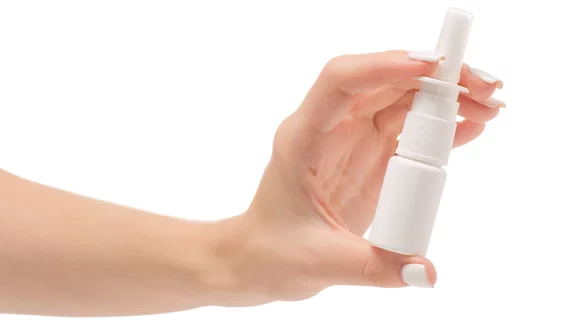A calcium-channel blocker delivered as a nasal spray rapidly restored individuals with paroxysmal supraventricular tachycardia (SVT) to normal sinus rhythm in a phase 2 study, raising the possibility that the drug could be self-administered in a real-world setting and prevent trips to the emergency department.
There are no nonparenteral drugs currently available that can be self-administered for the acute termination of SVT, Bruce S. Stambler, MD, and colleagues pointed out in the Journal of the American College of Cardiology.
Patients with previously documented SVT were induced into SVT in an electrophysiology lab prior to planned catheter ablation, then given either a placebo or a dose of the active compound. A total of 104 individuals were randomly assigned in equal numbers to placebo or four different drug doses (35, 70, 105 or 140 mg).
Patients given the etripamil nasal spray achieved conversion rates between 65 and 95 percent within 15 minutes of administration, compared to 35 percent of the placebo group. The 70 mg and 140 mg groups showed the highest conversion rates at 87 percent and 95 percent, respectively, but the authors suggested the 70 mg dose may be ideal for the next round of trials because it best balances safety and efficacy. The highest dose of etripamil was associated with drops in systolic blood pressure (SBP).
“From an efficacy standpoint, this makes this intranasal calcium-channel blocker an excellent drug candidate to fill the existing gap in therapy for the rapid termination of SVT outside of the health care setting,” wrote Stambler, with Piedmont Heart Institute in Atlanta, and coauthors. “Judicious selection of etripamil doses in future studies may be able to mitigate decreases in SBP, which occurred most often and for the longest duration in the etripamil 140-mg group.”
More than half of the patients given the three highest doses of etripamil converted to sinus rhythm within three minutes, with the quickest average conversion noted in the 140 mg group (1.8 minutes). Previous trials of oral beta-blockers or calcium-channel blockers to terminate SVT worked better than placebo, but still averaged more than 30 minutes to get the patient back to sinus rhythm, the researchers said.
Adverse events were common but most were mild or moderate and related to the intranasal route of administration or local irritation. There were three severe adverse events possibly related to etripamil, the authors reported: one instance of facial flushing, shortness of breath and chest discomfort; one case of nausea and vomiting; and one patient who experienced a serious cough.
“During the course of the study it was recognized that the discomfort and cough possibly related to the presence of the drug in the throat could be dramatically reduced by elevating the head of the bed to 30°, keeping the chin close to the chest, and trying to avoid inhaling or swallowing the drug,” Stambler et al. wrote. “It is conceivable that providing patients with this information could reduce or eliminate these adverse events in the future.”
The researchers reiterated the need for additional testing of the drug in the real-world setting, which may produce different results than observed in an electrophysiology lab. If successful, “this has the potential to change the treatment paradigm for the acute management of SVT,” Stambler and colleagues wrote.
In a related editorial, three researchers from Penn State University Heart and Vascular Institute said a history of syncope may be a contraindication for etripamil given its association with lowering blood pressure. They also believe additional hurdles must be addressed before the drug can be successfully administered without the guidance of a clinician.
“If one is going to use intranasal etripamil for acute termination of SVT, either as an outpatient or in the emergency department, one will still have to exclude appropriate or inappropriate sinus tachycardia or other atrial-origin tachycardia that will not respond to this therapy,” wrote Gerald V. Naccarelli, MD, Deborah L. Wolbrette, MD, and Mario D. Gonzalez, MD, PhD. “Before prescribing this therapy, patients may need to have an initial trial of this therapy in a controlled telemetry environment. If the therapy is ineffective or SVT recurs, the patient will need to be instructed to seek medical attention.”
That said, the editorialists agree etripamil nasal spray is a potentially attractive, cost-effective way to treat this arrhythmia outside of a healthcare facility. The short half-life of the drug is particularly important, they said, as any adverse effects will likely be transient.
“Although this would be a niche therapy for select patients, such a treatment is long overdue,” Naccarelli et al. wrote.

